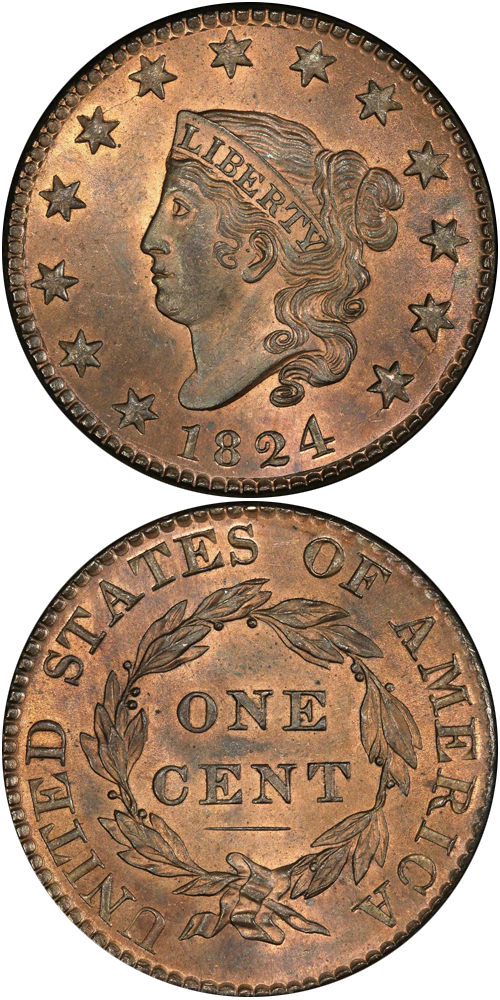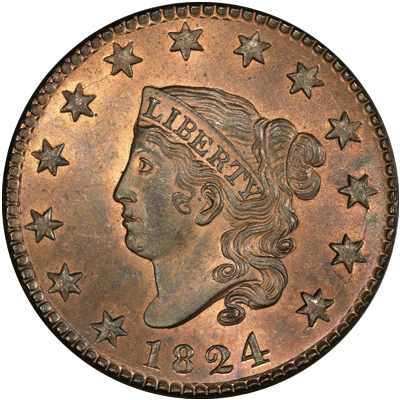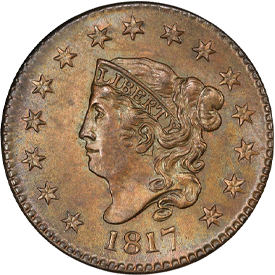Designed by: Robert Scot
Issue Dates: 1816-1835, plus 1839/6 overdate
Composition: Copper
Diameter: Average 28 to 29 mm
Weight: 10.88 grams (168 grains)
Edge: Plain
Business Strike Mintage: 47,765,912 (Mintage figure does not include 1837 cents of this style.)
The so-called Matron Head copper was produced in several variations from 1816 through 1837 (plus 1839/6). Miss Liberty is restyled and now sports a serious, even severe mien. Her hair is tied behind her head in a bun, with two plain cords, with additional tresses hanging downward. In her hair a diadem or coronet is inscribed LIBERTY. Thirteen stars surround, interrupted by the date at the bottom. The reverse is stylistically similar to that used in 1808-1814 and consists of a continuous wreath tied with a ribbon, enclosing ONE CENT, with UNITED STATES OF AMERICA surrounding.
This particular obverse style was used only on large cents and, unlike certain other large cent motifs, had no counterpart in the half cent series. In 1835 the head was slightly restyled; the change is most obvious at the point of the neck truncation. This new style is found on some 1835, all 1836 (and 1839/6) and some 1837 pieces and is distinguished by the small tip to the neck.
Specimens may be readily located in all grades from About Good to Uncirculated, although Uncirculated pieces are apt to be dated 1816 through 1820, particularly the years 1818 and 1820, remnants from the so-called Randall Hoard dispersed in the late 19th century. The quality of striking, smoothness of the surface, and other characteristics vary from date to date and variety to variety.
Further Reading
Nomenclature concerning later date large cents, those from 1816 through 1857, has never been defined precisely. The Guide Book suggests that those in the 1816 to 1835 range be designated as Matron Head varieties, while later issues have other designations, including Petite Head for certain issues from 1839 through 1843, and Mature Head for issues from 1843 through 1857. For purposes of the present book, I break the later date large cents into two categories, those I style as the Coronet type from 1816 through 1839, and the Braided Hair type from 1839 through 1857. There are several varieties within these classifications, each of which will be discussed. For purposes of a type set, the two main categories I have suggested will probably suffice for most. However, an expanded type set can be made to include others as well.
In January 1883, Frank D. Andrews published a monograph describing cents of the 1816 to 1857 years by minute die varieties. The effort met with mixed reviews, with one observer scornfully referring to the endeavor of such classification as a waste of time. Back then the large cent was familiar to most adult readers. Indeed, scarcely more than 25 years had elapsed since the discontinuation of the large-size format in 1857, and occasional specimens were still to be seen in the channels of commerce. While large cents of the earlier period, 1793 through 1814, had a classic aura, later issues suffered from familiarity and lack of age and were not viewed seriously. Since 1883 the study of die varieties has advanced considerably. Today, the discovery of even a minute difference, previously unpublished, among early issues is a cause for excitement.
In 1944, Howard R. Newcomb, a long-established numismatist, saw the publication of his masterpiece on the 1816-1857 series, an updating of the revision of the Andrews' work which Newcomb titled United States Copper Cents 1816-1857. While some varieties, such as the 1817 cent with 15 obverse stars instead of the usual 13, can be described simply, others require careful study and intense magnification to identify properly. It is not every numismatist who wishes to study 1851 cents by such differentiations as the relationship of the 1 to the point of the bust of Miss Liberty, or the relationship of the point of the hair curl to the digit 8. Still, the Newcomb book has had a following and has been reprinted several times.
Unlike the Sheldon system, which employs a continuous numbering system beginning with S-1 (the 1793 Chain AMERI. cent) and continues through the last variety of 1814, the Newcomb numbers begin anew each year. Thus, there is an N-1, an N-2, etc., for each year from 1816 through 1857. Since the Newcomb work was first published a number of new varieties have come to light, with the result that sometimes one sees such notations as "N-6½."
One advantage of collecting coins by minute varieties such as those listed in the Newcomb reference is that for many issues there is a possibility of finding rarities, even unlisted varieties, at no more than one would pay for the piece as a date. Indeed, most dealers do not attribute coins in auction sales or fixed price lists by Newcomb numbers, for there is relatively little demand for such classifications. Apart from including representative specimens of large cents of the 1816-1857 era in type sets, the most popular way to collect is by dates and major varieties. Such major varieties include overdates and noticeable differences in the portrait of Miss Liberty. Certain issues are listed by letter sizes, such as large letters and medium letters, but interest in these is not as intense.
The year 1816 saw the introduction of the Coronet cent, a motif that was continued for many years. Unlike most other nineteenth century cents, particularly issues dated prior to 1840, certain varieties of cents from 1816 through 1820 are obtainable in Uncirculated grade. On the other hand, dates such as 1821, 1822, and 1823, are exceedingly rare in the same preservation. Why are certain 1816-1820 pieces easy to find? The answer is provided by the famed Randall Hoard, which, along with the Economite Hoard, are perhaps the best-known groupings of early American coins ever to come to light – unless one considers the immense Treasury holdings of silver dollars released over a period of years, particularly 1962-1963.
In the early days it was the custom of the Philadelphia Mint to ship newly-minted coins in kegs or barrels. Shortly after the Civil War one or more of these kegs of new cents were found beneath an old railway platform in Georgia. The hoard proved to contain cents from several decades earlier, each coin as bright and gleaming as the day it was minted, but some with light flecks or spotting.
Following the discovery, the cents were shipped to a New York merchant to satisfy a debt. They were subsequently sold to a dry-goods store in Norwich, New York, the owner of which passed them along to John Swan Randall, a numismatist in the same town. It has been estimated that early Mint kegs held an average of 14,000 coins each, so even if the Randall Hoard consisted of but a single keg, the number of coins involved was tremendous. Although many pieces in the hoard were dated 1816, 1817, and 1819, the proportion of surviving specimens existing today indicates that 1818 and 1820 cents were the most plentiful.
In the early 1950s, when I began my interest in numismatics, such Randall Hoard pieces were fairly plentiful. Virtually every dealer had several in stock. In recent times the widespread interest in collecting has resulted in wide distribution of these colorful cents. Today one seldom sees such pieces in pairs or groups. A great toll of surviving specimens has been taken by misguided collectors who have cleaned these pieces in an attempt to make them bright orange. Today a nice appearing Randall Hoard cent, uncleaned and in Uncirculated grade, usually merits a sentence or two in a sale listing.
One of the most interesting varieties of the 1816 to 1820 years is the famous 1817 cent with 15 stars, instead of 13, on the obverse. The reason behind this variety has never been explained. Certainly, the error is too major to have been caused simply by accident. There are no other instances of wrong star counts among later date large cents, and the 15-star error is harder to explain than would be, for instance, a 14-star error (something which in itself would indeed be unusual).
The 15-star cent was not included among varieties represented in the Randall Hoard, so specimens in Uncirculated grade are exceedingly rare today. In fact, I have never seen one with a significant amount of original mint brilliance. It is probably safe to say that in Uncirculated grade, an 1817 15-star cent is a thousand times rarer than an 1817 13-star cent! However, popular catalogues do not treat the availability of different pieces in different grades, so it falls to the student or scholar to recognize that capturing an Uncirculated 15-star 1817 cent indeed represents a rare prize.
Another interesting 1817 cent, one infrequently mentioned (except in conversations among die variety specialists), is the Mouse variety, so-called from a mouse-like die break at the top of Miss Liberty's head.
Several overdates occur among Coronet cents, including 1819/8, 1820/19, 1823/2, 1824/2, 1826/5 (the existence of which is controversial; many consider it simply to be a recut date, not an overdate), and 1839/6.
Among cents of this period there are no great rarities. 1821 is considered to be slightly scarce. If the tag of "most elusive" has to be applied to a given date, the most logical candidate would be 1823. In higher grades the order changes, and, as noted, any Uncirculated large cent after 1820, through the end of the decade, is legitimately rare.
Proof large cents, made for inclusion in presentation sets and for distribution to numismatists and other interested people, are known for a number of dates. Among early issues Proofs are extreme rarities. Curiously, the most often seen Proof issue among large cents of the 1820s is the 1821, considered to be a scarce date as far as non-Proofs (business strikes) are concerned. Probably close to 20 Proofs are known for this year, including a stellar group of a half dozen pieces that I obtained years ago while handling a Main Line (Philadelphia suburbs) estate. By comparison, no Proofs at all exist for the year 1824. Other years are known in Proof condition only to the extent of a few pieces. During the 1830s Proof coinage increased, and specimens in general are less rare. Proofs of the 1840s are more frequently seen (but this still is not often), and those dated from 1854 through 1857 are observed with some degree of regularity. Still, as a class Proof large cents of any year are rarities. In my opinion, numerous coins listed as "Proof" in auctions over the years are not true Proof specimens but, rather, are prooflike business strikes. Thus, true Proofs are rarer than the literature indicates.
Curiously, some Proofs of the 1820s and 1830s are one-sided. The obverses are in Proof state, while the reverses display deep mint frost characteristic of business strikes. The explanation for this may be that such pieces were intended to be displayed face-up in a coin cabinet, the standard method of housing coins until portable holders became popular in the 1920s. Thus, there was no need to create a Proof surface on a side that would not be seen. Proof large cents are not likely to enter the realm of the average type set or date collector, but because they exist, they are mentioned here.
Large cents of the late 1820s and early 1830s contain no rare issues as far as dates are concerned. Uncirculated pieces, however, are elusive, and several dates can be ranked as rarities in this preservation.








